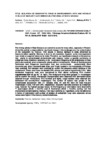Please use this identifier to cite or link to this item:
http://www.alice.cnptia.embrapa.br/alice/handle/doc/1027537| Title: | Isolation of endophytic fungi in environments with and without traces of mercury contamination, Pantanal of Mato Grosso. |
| Authors: | PIETRO-SOUZA, W.  VENDRUSCULLO, S. J.   MELLO, I. S.   LIOTTI, R. G.   BICHARA, K. P. A.   SILVA, G. F.   ALMEIDA, E. G.   NUNES DA CUNHA, C.   SOARES, M. A.   |
| Affiliation: | W. Pietro-Souza, UFMT; S. J. Vendruscullo, UFMT; UFMT; UFMT; KARINA PRYSCILLA DE ARAUJO BICHARA, CPAA; GILVAN FERREIRA DA SILVA, CPAA. |
| Date Issued: | 2015 |
| Citation: | In: CONGRESSO BRASILEIRO DE MICROBIOLOGIA, 28., 2015, Florianópolis. Anais... São Paulo: Sociedade Brasileira de Microbiologia, 2015. |
| Description: | The mining activity in Mato Grosso is an economic source for many cities, especially in Poconé, where this activity is responsible for significant change in the landscape and the contamination of the ecosystem by mercury. This results in serious damage to biota enhanced by bioaccumulation capacity. Mercury is toxic to all organisms, however, some microorganisms have innate or acquired tolerance to metal. Therefore, our hypothesis is based on the premise that plants in contaminated environments with mercury harbor a specific community of endophytic fungi, therefore, variations in the colonization frequency of the endophytes in these plants are expected, when compared to places without contamination. |
| Keywords: | Poconé Resistance Heavy metal Mining of gold |
| Type of Material: | Resumo em anais e proceedings |
| Access: | openAccess |
| Appears in Collections: | Resumo em anais de congresso (CPAA)  |
Files in This Item:
| File | Description | Size | Format | |
|---|---|---|---|---|
| R06461.PDF | 113,29 kB | Adobe PDF |  View/Open |









